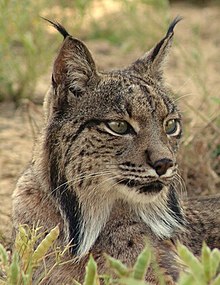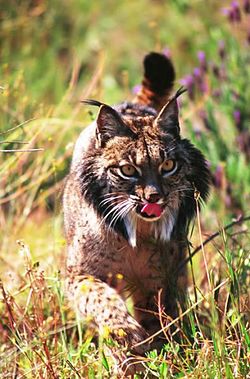 The Iberian lynx, Lynx pardinus,
is a critically endangered species of felid native to the Iberian
Peninsula in Southern Europe. It is one of the most endangered cat
species in the world.
According to the conservation group SOS Lynx, if this species died out,
it would be one of the few feline extinctions since the Smilodon 10,000 years ago. The species used to be classified as a subspecies of the Eurasian lynx (Lynx lynx),
but is now considered a separate species. Both species occurred
together in central Europe in the Pleistocene epoch, being separated by
habitat choice. The Iberian lynx is believed to have evolved from Lynx issiodorensis.
The Iberian lynx, Lynx pardinus,
is a critically endangered species of felid native to the Iberian
Peninsula in Southern Europe. It is one of the most endangered cat
species in the world.
According to the conservation group SOS Lynx, if this species died out,
it would be one of the few feline extinctions since the Smilodon 10,000 years ago. The species used to be classified as a subspecies of the Eurasian lynx (Lynx lynx),
but is now considered a separate species. Both species occurred
together in central Europe in the Pleistocene epoch, being separated by
habitat choice. The Iberian lynx is believed to have evolved from Lynx issiodorensis.Description
The head and body length is 85 to 110 centimetres (33 to 43 in), with the short tail an additional 12 to 30 centimetres (4.7 to 12 in); the shoulder height is 60 to 70 centimetres (24 to 28 in). The male is larger than the female, with the average weight of males 12.9 kilograms (28 lb) and a maximum of 26.8 kilograms (59 lb), compared to an average of 9.4 kilograms (21 lb) for females; this is about half the size of the Eurasian lynx.
Ecology
The Iberian lynx is smaller than its northern relatives, and typically hunts smaller animals, usually no larger than hares. It also differs in habitat choice, with Iberian lynx inhabiting open scrub and Eurasian lynx inhabiting forests.It hunts mammals (including rodents and insectivores), birds, reptiles and amphibians at twilight. The European rabbit (Oryctolagus cuniculus) is its main prey (79.5-86.7%), with (5.9%) hares (Lepus granatensis) and rodents (3.2%) less common. A male requires one rabbit per day; a female bringing up cubs will eat three rabbits per day.
As the population of rabbits in Spain and Portugal has declined due to myxomatosis, the Iberian lynx is often forced to attack young fallow deer, roe deer, mouflon, and ducks. The Iberian lynx competes for prey with the red fox, the meloncillo (Herpestes ichneumon) and the wildcat. It is solitary and hunts alone; it will stalk its prey or lie in wait for hours behind a bush or rock until the prey is sufficiently close to pounce in a few strides.
A lynx, especially with younger animals, will roam widely, with ranges reaching more than 100 kilometres (62 mi). Its territory (~ 10 to 20 square kilometres (3.9 to 7.7 sq mi)) is also dependent on how much food is available. Nonetheless, once established, ranges tend to be stable in size over many years, the boundaries often being along man-made roads and trails. The Iberian lynx marks its territory with its urine, droppings left in existing tracks through the vegetation, and scratch marks on the barks of trees.Reproduction

Specimen in the Doñana National Park
The kittens become independent at seven to 10 months old, but remain with the mother until around 20 months old. Survival of the young depends heavily on the availability of prey species. In the wild, both males and females reach sexual maturity at one year old, though in practice they rarely breed until a territory becomes vacant; one female was known not to breed until five years old when its mother died. The maximum longevity in the wild is 13 years.
Siblings become violent towards one another between 30 and 60 days, peaking at 45 days. A cub will frequently kill its littermate in a brutal fight. It is unknown why these episodes of aggression occur, though many scientists believe it is related to a change in hormones when a cub switches from its mother's milk to meat. Others believe it is related to hierarchy, and "survival of the fittest." No matter the reason, conservationists must separate the kittens until the 60 day period is reached.
Habitat
This lynx was distributed over the entire Iberian Peninsula as recently as the mid-19th century. It is now restricted to very limited areas of southern Spain, with breeding only confirmed in two areas of Andalucía. The Iberian lynx prefers heterogeneous environments of open grassland mixed with dense shrubs such as strawberry tree, mastic, and juniper, and trees such as holm oak and cork oak. It is now largely restricted to mountainous areas, with only a few groups found in lowland forest or dense maquis shrubland.Population

Graphic showing Iberian lynx population in Spain, 1950-2007
Studies conducted in March 2005 have estimated the number of surviving Iberian lynx to be as few as 100, which is down from about 400 in 2000 and down from 4,000 in 1960. If the Iberian lynx were to become extinct, it would be the first big cat species to do so since Smilodon populator 10,000 years ago.
The only breeding populations are in Spain, and were thought to be only living in the Doñana National Park and in the Sierra de Andújar, Jaén. However, in 2007, Spanish authorities announced that they had discovered a previously unknown population in Castilla - La Mancha (central Spain). It was later announced that there were around 15 individuals there.
The Iberian lynx and its habitat are fully protected, and they are no longer legally hunted. Its critical status is mainly due to habitat loss, poisoning, road casualties, feral dogs and poaching. Its habitat loss is due mainly to infrastructure improvement, urban and resort development and tree monocultivation, which serves to break the lynx's distribution area. In addition, the lynx prey population of rabbits is also declining due to diseases such as myxomatosis and hemorrhagic pneumonia.
In 2008, the Doñana population was assessed at 24 to 33, with an estimated 60 to 110 adults in the Sierra Morena, which is the stronghold of the species. The total population is estimated to be 99 to 158 adults, including the newly discovered La Mancha population, and the Iberian lynx qualifies as Critically Endangered under C2a(i) on the IUCN Redlist.

Iberian lynx in close-up
Conservation
Recent successful breeding programs have given renewed hope to survival of this species.- On March 29, 2005, Saliega, the first Iberian lynx to breed in captivity, gave birth to three healthy kittens at the El Acebuche Breeding Center, in the Doñana Nature Park in Huelva, Spain.On March 22, 2008, Saliega gave birth to three more kittens at the El Acebuche centre. These kits were born at 64 days gestation. One of the young was rejected by the mother, and the Junta de Andalucía’s Environment Department reported on March 24 that the rejected kitten had died.[18]
- In the Sierra Morena area just north of Andújar, Andalucía, there were 150 Iberian lynx individuals overall in 2008, up from 60 in 2002. As a result of this increase, the lynx area in Andújar-Cardeña has probably reached its carrying capacity, and thus could provide animals for future reintroductions elsewhere. In addition to these on-site conservation achievements in the Sierra Morena, the off-site conservation captive breeding program has also progressed well, totaling 52 individuals, 24 of which were bred in captivity. The off-site conservation population will provide 20 to 40 individuals per year for reintroductions beginning in 2010.
- In Doñana National Park, the lynx population seems to have remained steady in recent years, with around 50 individuals reported in total each year between 2002 and 2008. In March 2009, the birth of three more kittens was announced; they were born as part of the breeding program at Doñana National Park, in Huelva. The Iberian Lynx is planned to be reintroduced into Guadalmellato beginning in 2009, and into Guarrizas sometime in 2010 - 11.
- In March, 2012, seven Iberian Lynx cubs were born to two adult females at the Iberian Lynx reproduction centre in Silves, Portugal. The centre is Portugal's only dedicated lynx reproduction centre. On 5 March, the female lynx Biznaga gave birth to three cubs. "Two of the cubs were abandoned (by the mother) one hour after the birth, so their survival depends on incubators and artificial feeding," said a spokesman from the Institute of Nature Conservation and Biodiversity (ICNB). The third cub died after 48 hours, despite the mother having "demonstrated normal parenting care." This was the second time Biznaga has given birth to cubs. Last year, she gave birth to two for the first time, but abandoned them after a few hours, which is considered normal behaviour for first time mothers of this species. These first cubs also died.
- Aside from Biznaga, another female, called Castañuela, gave birth to four cubs on 6 March. The size of this litter was unusual, as litters of two or three are the norm for this species. "This female shows great dedication and is caring for all her kittens," said the ICNB spokesman.
- The Iberian Lynx breeding season begins in December and ends in April. At Silves, a total of nine pairs of lynx were chosen for breeding, with more cubs expected in the coming days. The Silves reproduction centre currently has 18 Iberian lynx, nine females and nine males, 13 of which arrived from neighbouring Spain when the centre opened in 2009. This is the second year of reproduction at the centre in Silves, although no cubs survived from the first year.
No comments:
Post a Comment